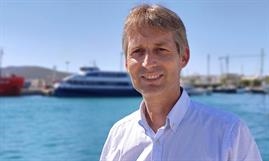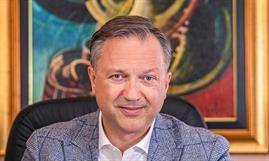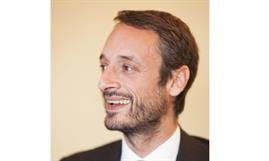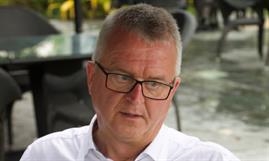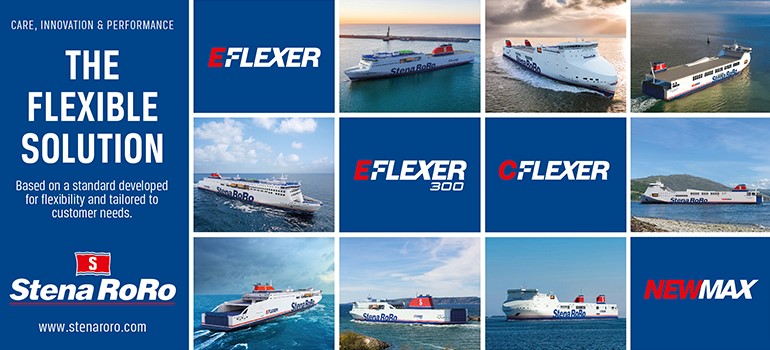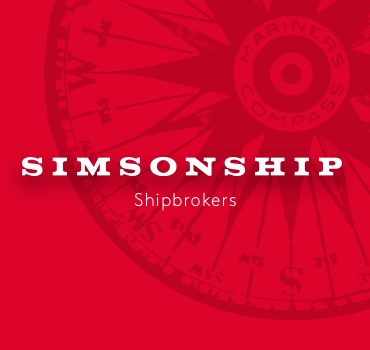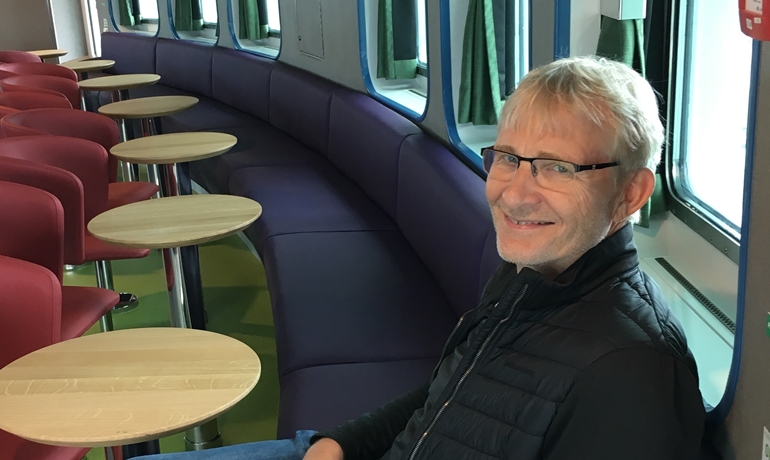
Johannes Johannesson © Johannesson
JJohannesson ApS – a multidisciplinary niche naval architecture consultancy
InterviewTo guarantee short turnaround times in shuttle ferry operations, it is of paramount importance also to get things right on the land side by, for instance, clearly separating the vehicle traffics. Scandlines managed to trim turnaround times on its Rødby-Puttgarden and Gedser-Rostock shuttle services to 15 minutes each and nicknamed them ‘traffic machines’. Shippax spoke to one of the designers of this system, Johannes Johannesson, the Danish naval architect who, among many of his achievements, was also responsible for the concept design of the Icelandic domestic ferry HERJÓLFUR.
“I worked on the concept design of the ferry you just arrived on,” Johannes Johannesson told me when he picked me up from the railway station at Espergærde, the second stop on the Helsingør-Copenhagen rail link. The ferry he referred to was ForSea’s 1991-built TYCHO BRAHE. Ten minutes later, I was seated in a sofa in his living room. “Many ferry projects started here on my kitchen table,” he said, pointing to the table on the other side of the door that separated the living room from the kitchen.
At the age of 64, Johannesson’s retirement still seems to be far in the future, as he is deeply involved in the electrification and the zero-emission target of North European ferry services, something that will keep him busy for many years to come.
Born and bred in Iceland, Johannesson began studying naval architecture in Helsingør at the age of 21. “It was a late calling,” he explained. “I had a big interest in working in fishing vessel designs before moving to Denmark to study. I chose to specialise in naval architecture in order to be able to do this and chose the school in Helsingør because it seemed for me a good school. Things turned out differently for several reasons; one of them being that I met my wife here in Denmark. I didn’t return to Iceland and didn’t design a single fishing vessel.”
Upon graduating in 1980, Johannesson moved to Norway to work in the fields of stability and load lines in DNV’s Høvik headquarters. Two years later, he got involved in R&D on damage stability, which also included the development of damage stability software.
After four years with DNV, Johannesson and his wife moved back to Denmark where he joined the engineering office of Burmeister & Wain, which in those days was developing double hull product tankers. Another two years later, Johannesson was approached by DNV for an ad hoc project that focused on further developing damage stability software, as PC technology was advancing fast.
Ultimately, Johannesson wanted to design ships. When the project with DNV ended, he was hired by Dwinger Marineconsult, one of the then biggest naval architecture consultancies in Denmark, which became part of Carl Bro in 1987. “Dwinger Marineconsult was behind many newbuilding projects for the state-owned Danske Statsbaner (DSB),” Johannesson explained, “and I joined them shortly after the delivery of DSB’s Kalundborg-Århus ferries, PEDER PAARS and NIELS KLIM, which Dwinger Marineconsult had designed.”
Enter the traffic machine
“The decision to build a fixed link across the Great Belt was taken in the same period,” Johannesson told us. “In those days, there were already capacity constraints on the Knudshoved-Halsskov route, with often long queues, especially during weekends and other holiday periods. DSB was obliged by the government to offer a high-performing ferry service. Dwinger Marineconsult was hired in to find a solution for drastically reducing the queues on peak days. Rather than adding tonnage we managed to increase capacity by primarily reviewing terminal operations where inbound and outbound vehicle traffics were clearly separated, as were the vehicles for the main and upper vehicle decks. This, in turn, led to shorter turnaround times, which allowed a higher frequency, effectively increasing capacity. The term ‘traffic machine’ was then first coined. More than thirty years on, the model is still working.”
That was only the beginning, Johannesson’s role in ferry designs went much further. “In the meantime, in close cooperation with the Danish and Swedish railways, we also developed the new double-ended shuttle ferries for the Helsingør-Helsingborg route,” he said. “I participated in this project all the way from the blank sheet of paper to the commissioning of the vessels. Besides being part of the design team, I was also involved in re-organising the land side of the business, similar to what was done for the Great Belt ferry operation. In those days, DSB was still focusing heavily on the train element, but we masterminded the way to handle ro-ro traffic more efficiently, creating a ‘traffic machine’ on the Sound.”
Following the successful introduction of the double-enders, TYCHO BRAHE and AURORA AF HELSINGBORG, it was time for Johannesson to move to pastures new. He became Chief of Construction at Århus Dockyard in 1993. “During my tenure there, we delivered no fewer than 26 newbuilds,” he said. “The first ships were the last four in a series of seven chemical carriers designed by Carl Bro. They were followed by eight 800-TEU-capacity container feeder vessels for Elite Shipping, six small reefer vessels for Russian interests, and eight chemical tankers for Italian owners. Sadly, the Russian customer killed the yard. Even so, I managed to finalize the two last vessels for our Italian client in 1999 when the yard was already in receivership. I’m particularly proud of this achievement.”
The way to Scandlines
With Århus Dockyard closed, time had come for yet another challenge. Johannesson took up the technical director position at Knud E. Hansen. “Knud E. Hansen was still headquartered in Copenhagen,” said Johannesson. “The Swedish Pelmatic Group had just sold the company to Semcon AB. At the turn of the century, Knud E. Hansen was quite busy on the ferry front with newbuilding projects for Stena, Gotlandsbolaget, Superfast Ferries, and Strandfaraskip Landsins. We also did the pre-project planning for the rebuilding of Scandlines’ Gedser-Rostock ferries – KRONPRINS FREDERIK and PRINS JOACHIM. After successfully implementing the ‘traffic machine’ principle on the Rødby-Puttgarden route following the 1997 introduction of the four double-enders, Scandlines was poised also to implement this on its Gedser-Rostock route. With the re-engining of KRONPRINS FREDERIK and PRINS JOACHIM, crossing times could be reduced from 120 to 105 minutes. Turnaround times were trimmed to 15 minutes, making a four-hour roundtrip possible. This allowed Scandlines to dispose of DRONNING MARGRETHE II, the third ship on the route, without affecting the overall capacity.”
By the time of KRONPRINS FREDERIK and PRINS JOACHIM being re-engined at Blohm+Voss, Johannesson had already left Knud E. Hansen for Scandlines where he assumed the role of head of newbuildings and conversion. “So, wearing a different hat, I continued with the re-engining project of KRONPRINS FREDERIK and PRINS JOACHIM,” said Johannesson, convivially. “In those days, Scandlines was a major ferry operator still under the control of DSB and Deutsche Bahn. Scandlines had a fleet of about 30 vessels. Besides domestic ferry services in Denmark – which had already shrunk due to the opening of the fixed Great Belt link – Scandlines was also active on international lines and had expanded its ferry services to the Baltic States.”
The ownership of Scandlines changed in 2007 when the Danish Ministry of Transport and Deutsche Bahn sold their respective 50-per-cent interests in the company to a consortium made up of Allianz Capital Partners, 3i Group, and Deutsche Seereederei. More ownership structural changes followed with Scandlines gradually being divested to what it is today – operating the Rødby-Puttgarden and Gedser-Rostock ferry services, as well as three BorderShops in the ports of Puttgarden and Rostock.
“Following the privatisation of Scandlines, I left the company in 2008,” Johannesson elaborated on his next career step. “I started my own maritime engineering company – JJohannesson ApS – and reached an agreement with Scandlines for further cooperation on the Gedser-Rostock newbuilding project, which had just started and I was very much part of that.”
Designing the pair
Gedser-Rostock is perhaps one of the most challenging ferry operations in Europe, with very short turnaround times, tight confines in the port of Gedser, and shallow water for a good part of the crossing. “Shortly after the re-engining of KRONPRINS FREDERIK and PRINS JOACHIM, Scandlines wanted to develop two new ferries for the route, keeping the 15-minute turnarounds and the one-hour-45-minutes crossing time,” said Johannesson. “We wanted to increase the lane capacity to the factor of 2.5 compared to that of the ships they would replace. Each of the new ships would have a 1,500-passenger intake. Needless to say, this was a very ambitious project. Developing a new ferry is not only a question of the vessel and the harbours; the money is also earned on board in the shops and the restaurants. This is a complex process where all interests must end in good harmony. This is the most important role of the designer. Studies were carried out to find the most suitable solution for both vessel and harbour. The conclusion was new double-deck shore linkspans had to be installed in both Gedser and Rostock. The shallow-draft ships were the biggest ever to serve Gedser and were designed as Gedser-max vessels. Good manoeuvrability was essential with each of the ships having two Azipulls and a central propeller. The port of Gedser was adapted to host larger vessels and the entrance channel to the port was deepened from seven to 7.5 metres.”
The ships were ordered at P+S Werften, a merger of the Volkswerft Stralsund and Peene-Werft, which had hitherto never built complex ro-pax vessels. The project derailed in 2012 when deadweight problems emerged.
“It was not only deadweight problems,” Johannesson pointed out. “There were also stability issues, simply because the ships were too heavy and too top heavy. This was mainly due to poor management from the side of P+S Werften and lack of knowledge on the yard side. After the contract had been signed, we strongly recommended the yard to hire an external consulting naval architect to assist them with the basic design, but they ignored our advice.”
Double-enders that never were
In the same year, P+S Werften filed for insolvency and, as long as the yard was in receivership, Scandlines could not take control of the as yet uncompleted BERLIN and COPENHAGEN. While this protracted saga was being played out, Scandlines initiated a new project to replace KRONPRINS FREDERIK and PRINS JOACHIM.
“We started again with a blank sheet,” Johannesson explained. “Back in 2013 it seemed as though LNG was to be the fuel of the future. So, LNG-hybrid propulsion was specified for this project, as Scandlines had gained experience with hybrid propulsion following the retrofit of batteries on our Rødby-Puttgarden ferries. Scandlines opted for a double-ender concept with a single propeller, single rudder, and twin bow thrusters. Because of the financial crisis, these vessels ended up being built a bit smaller and, with this smaller size requirement, a double-ender would be more efficient. The concept was sent out to several yards and, in summer 2013, Scandlines signed an LoI with STX Finland’s Rauma shipyard. As STX Finland’s South Korean parent company was in deep financial trouble, its Finnish subsidiary didn’t get financing to build the vessels. It was back to square one. But, in early January 2014, Scandlines managed to buy BERLIN and COPENHAGEN out of the receivership and brought them immediately to Blohm+Voss with whom we were in negotiation to rebuild them. Scandlines eventually didn’t manage to sign a contract and the ships were rebuilt at Fayard in Denmark. To get the deadweight and stability problems right, we rebuilt the ships from the top of the upper vehicle deck. Almost a complete passenger deck was discarded, reducing the passenger capacity [of each unit] from 1,500 to 1,300.”
Before the troubles with BERLIN and COPENHAGEN started, Johannesson had been deeply involved in designing newbuilds for Danske Færger. Altogether, the company ordered three diesel-electric double-enders at Sietas, but only two were eventually delivered, as this yard also went into receivership when the ships were still under construction. Danske Færger was previously part of Scandlines. During Johannesson’s time there, the idea of developing new vessels for the route was already in existence.
“Similar to what I did for Scandlines, I developed the concept design and specifications for new ferries for the Langeland and for the Samsø routes. This was done in close cooperation with the owner, Danske Færger, and the crew. The contract was signed for the Spodsbjerg-Tårs ferries LOLLAND – built as SAMSØ, as she was initially earmarked for the Hou-Sælvig service – and LANGELAND,” said Johannesson. “The project was then further developed by Sietas. They made both basic and detail design, following closely the concept design. Besides providing the concept and specifications, as a member of the on-site team, I was also working on the drawing approval and the contract follow-up during construction.”
The latest masterpiece
In 2012, Johannesson was contacted by the Icelandic Ministry of Transport and Local Government to discuss a possible newbuilding project with the aim of replacing the then 20-year-old HERJÓLFUR on the 45-minute, seven-nautical-mile lifeline service between the Icelandic mainland port of Landeyjahöfn and Heimaey in Vestmannaeyjar.
Newbuilding plans for this project had been on the table for quite some time, but they were thwarted by the financial crisis that hit Iceland hard towards the end of the last decade.
“The Icelandic transport authorities knew me well, as I had earlier done consultancy work for them,” said Johannesson, who had quite an extensive network of contacts in his native country. “This time they asked me if I could develop a concept design for this challenging Landeyjahöfn-Heimaey service. I then looked around the world to find out whether or not there was another open-sea ferry operation having to deal with similar enormous swells and currents to the ones encountered by ships approaching Landeyjahöfn. Well, there wasn’t, or at least I did not find one. The seas along the Norwegian west coast can be rough, but most fjord ferry operations are in sheltered waters. The problem in Landeyjahöfn is the shallow water and seas that are building up and when sailing into Landeyjahöfn the condition is one of following seas. To be able to operate the ferry service, a large weather window is needed; otherwise the community is not well served. The challenge was to design a ferry that could operate in high winds, cross current, and following seas all at the same time. Everything was critical on this vessel, especially the weight due to the shallow water in which it operates. But, eventually, I created the concept design and design specifications. This involved a lot of research and investigation beforehand. It was done in association with FORCE Technology in Denmark, the company that performed the tank tests. Several hull types, including a double-ender, were tested. Once the concept design and the specifications had been finalised, a tender was sent out for the basic design that would include extensive model tests and simulations, which was won by Polarkonsult in Harstad, Norway, and FORCE Technology.”
HERJÓLFUR was built by CRIST in Gdansk, which delivered the ship almost one year late. According to Johannesson, this delay was not because of technical problems; it was caused by an underestimation of the ship’s complexity. During the building process, it was also decided to increase the battery capacity to 3MWh in an effort to enable full-electric operations. Initially HERJÓLFUR operated on a hybrid-electric mode; while this article was being written, the commissioning of the charging system was being carried out for operation on the full-electric mode, using the plug-in facilities on the vessel and in both the ports of Landeyjahöfn and Heimaey.
Johannesson was also hired for the drawing approval, on-site inspection, and contract management of the ferries during the construction process. “I was the contract and project manager on behalf of the owner with my own on-site team of Polish and Turkish personnel who had been provided by the German Schulte Group. This turned out to be a very good experience, working with very capable and professional people.”
With HERJÓLFUR now in operation, Johannesson has been assisting the Icelandic Road and Coastal Administration (Vegagerdin) in a project aiming at improving the harbours. “It is not just the vessel,” he said. “It is also about the interaction between the ship and the port – both on the land side and on the sea side of the port, ensuring smooth loading and unloading operations of the ferry for both cars, freight, and people. In Heimaey, we cannot change the port layout, the harbour is in the centre of the city, but piers, berths and facilities can be improved.”
A niche breed
Without giving any details, Johannesson revealed that he was working on other ferry electrification projects. “Electrification and zero emission are high on the agenda of many ferry operators,” he told us. “I’m part of this, being involved in both retrofits and newbuilding projects.”
Johannesson underlined that he was kind of a niche naval architecture consultant. Although he could theoretically retire soon, this somehow seemed to be out of the question. “I love this job. It’s a small world where everybody knows everybody.”
© Shippax / Philippe Holthof
dec 01 2019
Most read
Carnival Corporation full-year results
dec 21 2025
Not a Merry Christmas for CMAL and CalMac as two newbuilding ferries – GLEN ROSA and ISLE OF ISLAY - are further delayed
dec 22 2025


